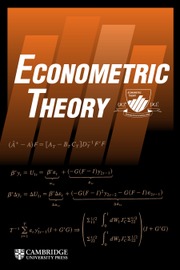No CrossRef data available.
Article contents
LEAST TRIMMED SQUARES: NUISANCE PARAMETER FREE ASYMPTOTICS
Published online by Cambridge University Press: 17 February 2025
Abstract
The Least Trimmed Squares (LTS) regression estimator is known to be very robust to the presence of “outliers”. It is based on a clear and intuitive idea: in a sample of size n, it searches for the h-subsample of observations with the smallest sum of squared residuals. The remaining  $n-h$ observations are declared “outliers”. Fast algorithms for its computation exist. Nevertheless, the existing asymptotic theory for LTS, based on the traditional
$n-h$ observations are declared “outliers”. Fast algorithms for its computation exist. Nevertheless, the existing asymptotic theory for LTS, based on the traditional  $\epsilon $-contamination model, shows that the asymptotic behavior of both regression and scale estimators depend on nuisance parameters. Using a recently proposed new model, in which the LTS estimator is maximum likelihood, we show that the asymptotic behavior of both the LTS regression and scale estimators are free of nuisance parameters. Thus, with the new model as a benchmark, standard inference procedures apply while allowing a broad range of contamination.
$\epsilon $-contamination model, shows that the asymptotic behavior of both regression and scale estimators depend on nuisance parameters. Using a recently proposed new model, in which the LTS estimator is maximum likelihood, we show that the asymptotic behavior of both the LTS regression and scale estimators are free of nuisance parameters. Thus, with the new model as a benchmark, standard inference procedures apply while allowing a broad range of contamination.
- Type
- ARTICLES
- Information
- Creative Commons
- This is an Open Access article, distributed under the terms of the Creative Commons Attribution licence (https://creativecommons.org/licenses/by/4.0/), which permits unrestricted re-use, distribution, and reproduction in any medium, provided the original work is properly cited.
- Copyright
- © The Author(s), 2025. Published by Cambridge University Press
Footnotes
Comments from P. Guggenberger and the referees are gratefully acknowledged.


